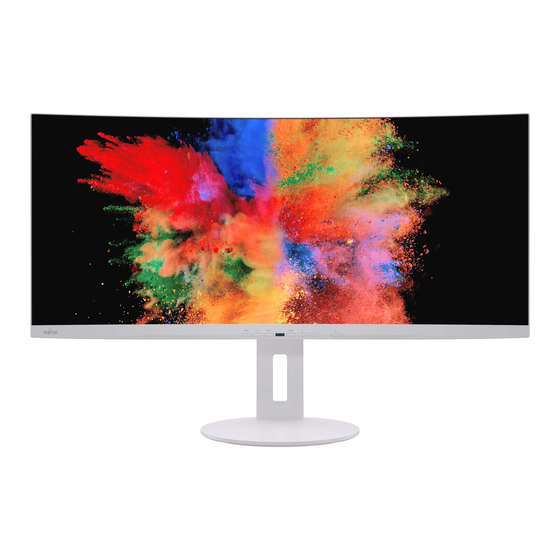
Table of Contents
Advertisement
Quick Links
Advertisement
Table of Contents

Summarization of Contents
Important notes
Safety instructions
Guidelines for safe operation and handling of the device.
Power cable
Guidelines for using and replacing the power cable.
Transporting the device
Instructions for safely moving the monitor.
Cleaning the device
How to clean the monitor safely.
CE marking
Compliance with EU directives.
Disposal and recycling
Information on environmentally friendly disposal of the device.
Getting started
Unpacking and checking the delivery
Steps for unpacking and verifying the contents of the package.
Setting up the device
Basic steps for setting up the monitor.
Setting up an ergonomic video workstation
Guidance for optimal ergonomic workstation setup.
Adjusting height
How to adjust the monitor's height.
Adjusting the inclination
How to adjust the monitor's tilt angle.
Adjusting the rotation
How to rotate the monitor.
Removing monitor base
Instructions for detaching the monitor base.
Connecting the device
General information about connecting the monitor.
Connecting cables to the monitor
Detailed steps for connecting cables.
Connecting cables to the computer
How to connect the monitor to a computer.
Operation
Switching the device on and off
How to power the monitor on and off.
Notes on the ambient light sensor and presence sensor
Explanation of sensor functions for power saving.
Changing the monitor settings
How to adjust monitor settings via the OSD.
Functions of the control panel and the OSD menu
Overview of control panel buttons and OSD menu.
Select OSD language
How to choose the OSD menu language.
Setting screen display
Adjusting image parameters like sharpness and saturation.
Adjusting Picture in Picture
How to configure Picture-in-Picture mode.
Configuring the OSD menu
Customizing OSD settings like language and timeout.
Advanced setting functions
Accessing advanced settings like Presence Sensor and Daisy Chain.
Displaying information
How to view monitor details like model and serial number.
Activate/deactivate ECO operating mode
Energy saving mode activation and its effects.
Selecting the input signal
Switching between different video sources.
Selecting the application mode
Choosing preset display modes for different content.
Setting colour temperature and colours
Adjusting colour settings for optimal display.
Adjusting the volume
Controlling the monitor's built-in speakers.
Adjusting the brightness and contrast
Fine-tuning display brightness and contrast levels.
Locking the OSD menu
Preventing unauthorized changes to monitor settings.
Lock the ON/OFF button
Preventing accidental power button presses.
Using the Daisy Chain function
Connecting multiple monitors in a series.
Driver installation
Driver installation overview
Overview of the driver installation process.
Monitor drivers
Detailed steps for installing monitor drivers.
Network drivers
Detailed steps for installing network drivers.
Notes on the program "DisplayView"
DisplayView introduction
Introduction to the DisplayView software.
DisplayView presence sensor settings
Using DisplayView for presence sensor settings.
DisplayView rotation function
Using DisplayView for screen rotation.
DisplayView desktop partitioning
Using DisplayView for desktop layout.
Notes on power management
Power management support
How the monitor supports computer power saving modes.
ECO operation details
Details about the ECO operating mode.
Notes on USB Power Delivery (USB-PD)
USB Power Delivery Specifications
Details on power supply capabilities via USB-C and USB-A ports.
Notes about the KVM function
KVM Functionality Overview
How the KVM function allows switching between computers.
Notes on All-in-One operation
All-in-One operation with ESPRIMO G
Settings for All-in-One operation with ESPRIMO G.
All-in-One operation with LIFEBOOK / STYLISTIC
Settings for All-in-One operation with LIFEBOOK/STYLISTIC.
Monitor settings for All-in-One operation
Monitor settings for All-in-One operation.
Operating system settings for All-in-One
Windows settings for All-in-One operation.
Notes on the HDR mode
HDR mode information
Information about the High Dynamic Range display mode.
Notes on low blue light mode
Low blue light feature explanation
Explanation of the low blue light feature for eye comfort.
Notes on ergonomic colour adjustment
Ergonomic colour combination guidance
Guidance on selecting suitable color combinations for readability.
Explanatory information about standard ISO 9241-307
Pixel and subpixel faults
Explanation of pixel and subpixel faults according to ISO standard.
Troubleshooting
Troubleshooting common problems
Common problems and their solutions.
Technical specification
Product identification
Identifies the product name and model.
Physical dimensions and weight
Physical specifications of the monitor.
Electrical characteristics
Electrical characteristics and power requirements.
Environmental conditions
Operating and storage environmental requirements.
Preset operating modes
Factory configured display modes.
Most frequent operating modes
Common PC and video timing specifications.
Displayport socket pinout
Pinout and meaning for the DisplayPort connector.
HDMI port pinout
Pinout and meaning for the HDMI connector.
USB-C port pinout
Pinout and meaning for the USB-C connector.
Appendices
Compliance and standards links
Links to compliance certificates and standards.













Need help?
Do you have a question about the P34-9 US and is the answer not in the manual?
Questions and answers